
These Soft Potato Pretzel Bites are healthy, packed with nutrients, and delicious. Made with sweet potato dough to reduce the carbs and increase the nutritional value, these soft pretzel bites are just perfect for munching on during the day, and can be enjoyed guilt-free.
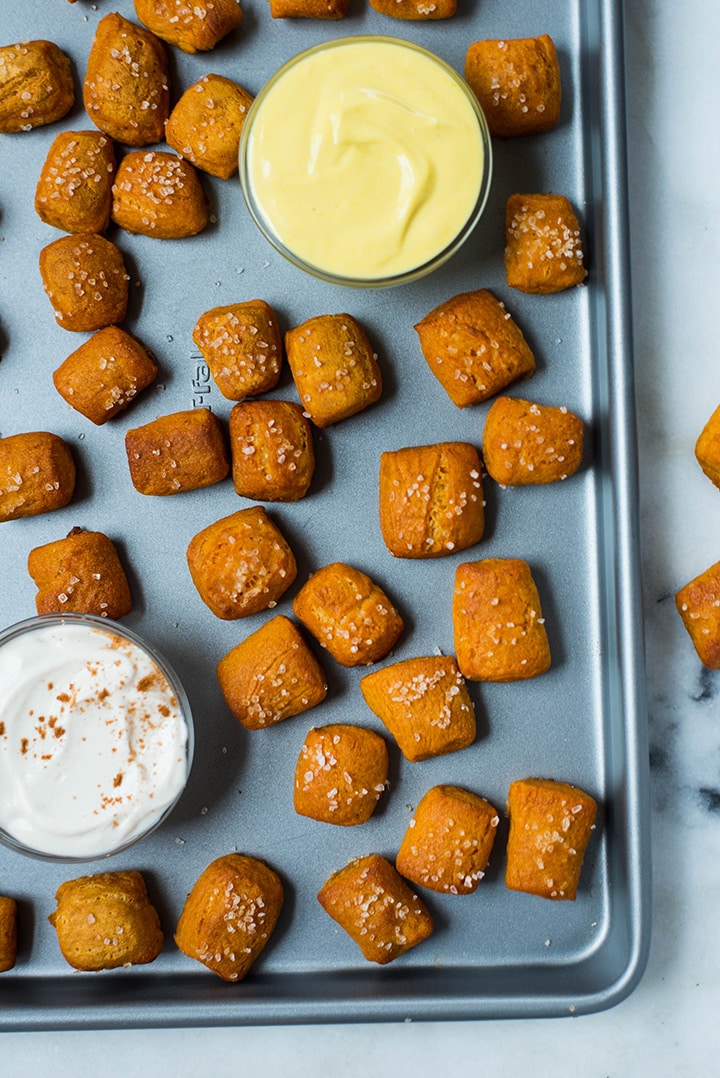
What are your favorite fair foods? Mine are definitely pretzels. Or pretzel bites.
Pretzels are not good for you, Lacey. I know, I know. I’m glad you’re looking out for me. But don’t worry, no matter how much I love the classic soft pretzels and classic pretzel bites, I still love clean eating so I’m aware that pretzels are basically refined carbs that give you an overdose of salt and no real nutritional benefits.
My pretzel bites are different though. For realz.
These sweet potato pretzel bites are made with sweet potato dough, they are baked in the oven and they are super healthy and good for you. And, since pretzel bites are no pretzel bites unless you dip them in sauce, I have 2 different dipping sauces for you. Both of them are healthy and both of them are YUMMY.
Before we start talking about this soft pretzel recipe that will teach you how to make pretzel bites and how to make homemade soft pretzels (the regular size version), let me tell you a few things about the soft pretzels.
These homemade pretzels…
Have a crunchy exterior and a soft interior. Are very easy to make so don’t be intimidated by the sweet potato dough or the recipe steps. This is an easy pretzel recipe. I promise you that. Are as cute as they can be. Plus they are perfect for October. Orange is the perfect color for October, am I right?Sound good?
Alright. Let’s begin the easy pretzel bites adventure then.
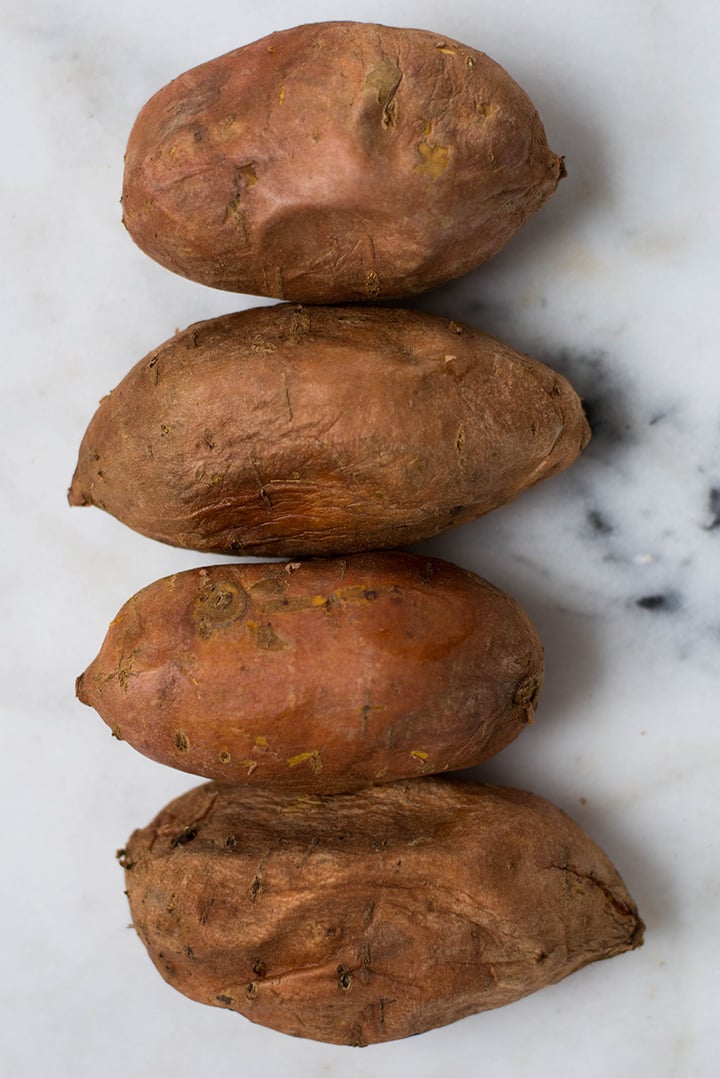
If you thought learning how to make pretzel bites is hard, you couldn’t be more wrong, my friend. It’s actually easier to learn how to make pretzel bites than to learn how to make homemade pretzels. No twisting into pretzel shape involved. However, if you prefer pretzels to pretzel bites, you can totally do it. For now, let’s focus on the making of the soft pretzel bites. To make them you have to:
Make the dough. Roll the dough. Cut the dough. Dump the bites in a baking soda bath. Bake.See? Easy.
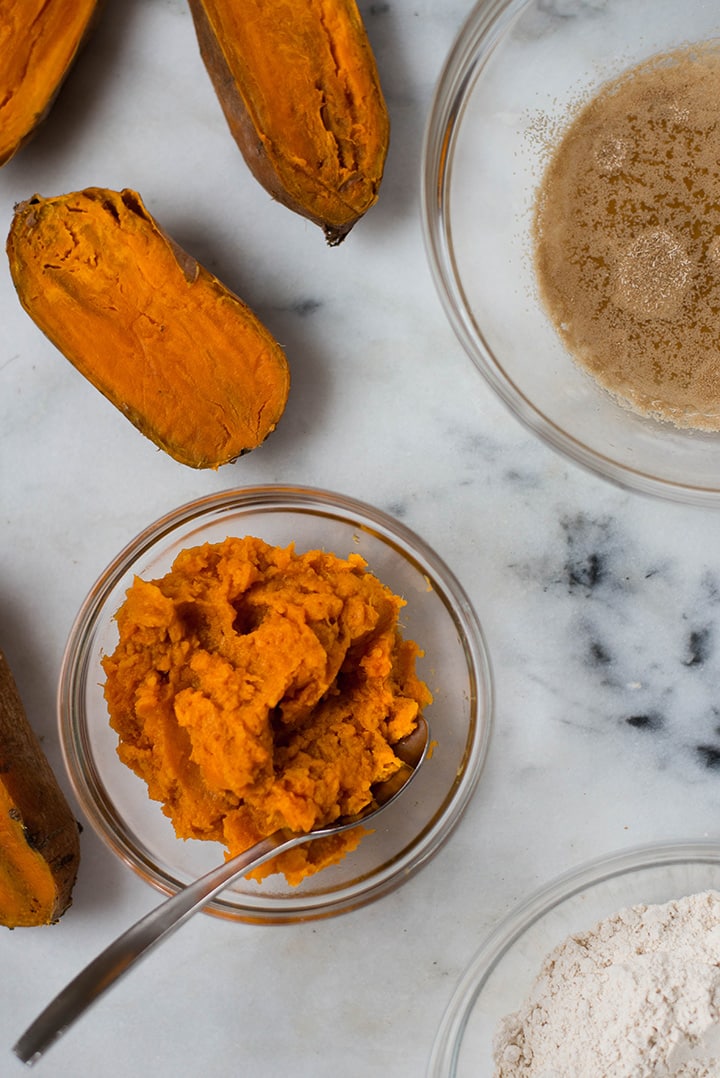
If you’re wondering why I use sweet potato dough, it’s because I want my pretzel bites to be healthy and packed with nutrients. Also because I love my sweet potato recipes a lot.
In case you didn’t know, sweet potatoes are:
Rich in fiber; A good source of vitamin B and vitamin C; Rich in minerals including calcium, iron, and selenium; High in beta-carotene, an antioxidant that converts to vitamin A when consumed.Plus they’re naturally dense and sweet, making them the perfect add-in for homemade dough.
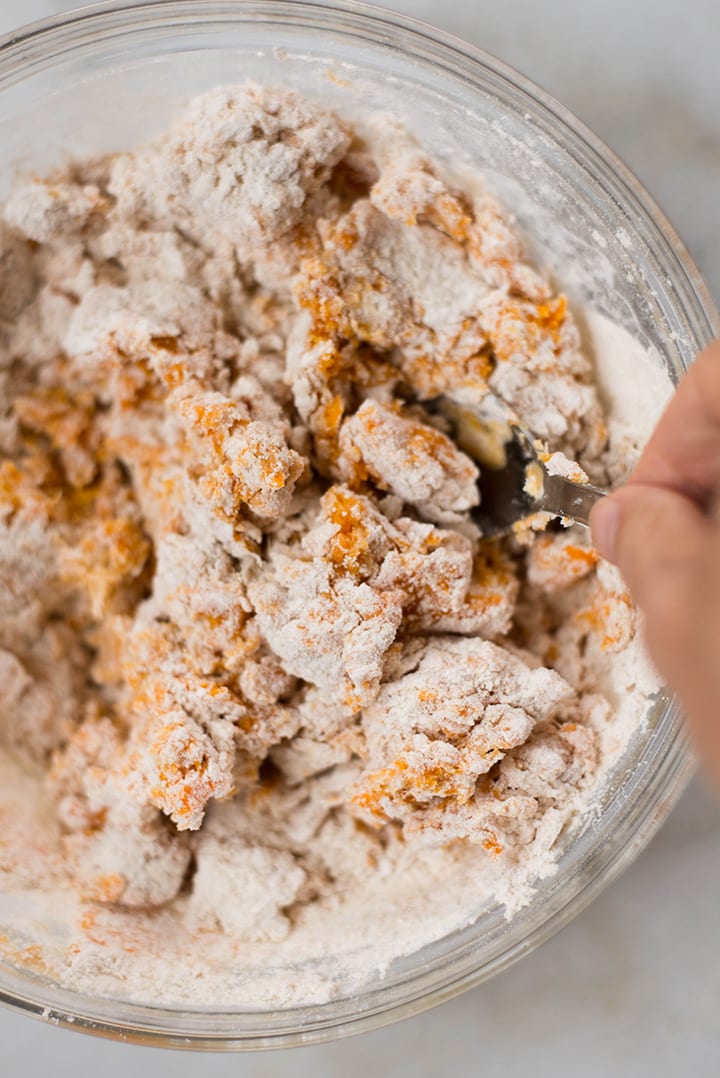
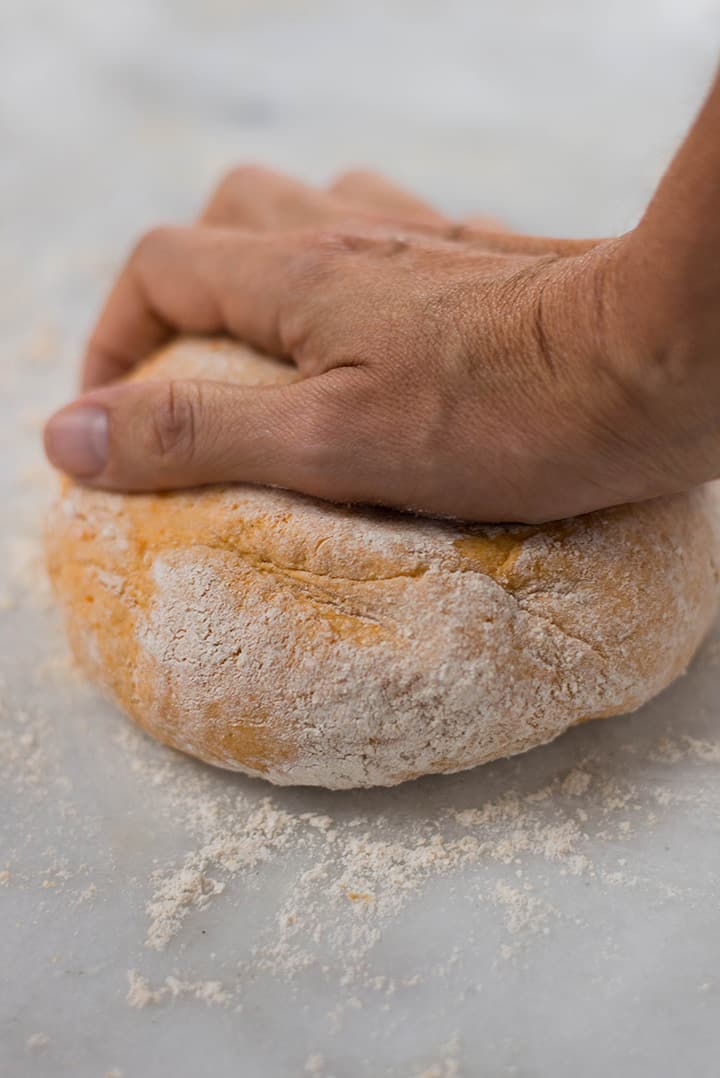
To make sweet potato dough, you’ll need:
Warm water; Pure maple syrup; Coconut oil; Sea salt; Quick (AKA Instant) rise yeast; Cooked and mashed sweet potatoes; Whole wheat pastry flour; Coarse sea salt.As for the steps required to make this potato dough, we will need to:
Mix warm water, pure maple syrup, coconut oil, sea salt in a bowl. Stir until combined. Add active yeast and let sit for approximately 8 minutes. Add whole wheat pastry flour and the sweet potatoes in the bowl. Stir once again until everything is fully combined and the dough is no longer sticky in your hands. Flour a surface. Lay the dough and knead for 3 to 5 minutes. Model the dough into pretzel bites. Cut into bites!Bonus tip – if the dough is very sticky and wet after you mixed all the ingredients together, you can add more flour. Start with a tablespoon and stir. Repeat until the dough pulls away from the sides of the bowl and you are able to model it in your hand without it sticking to it.
That’s it, folks. Now you know all my sweet potato dough secrets.
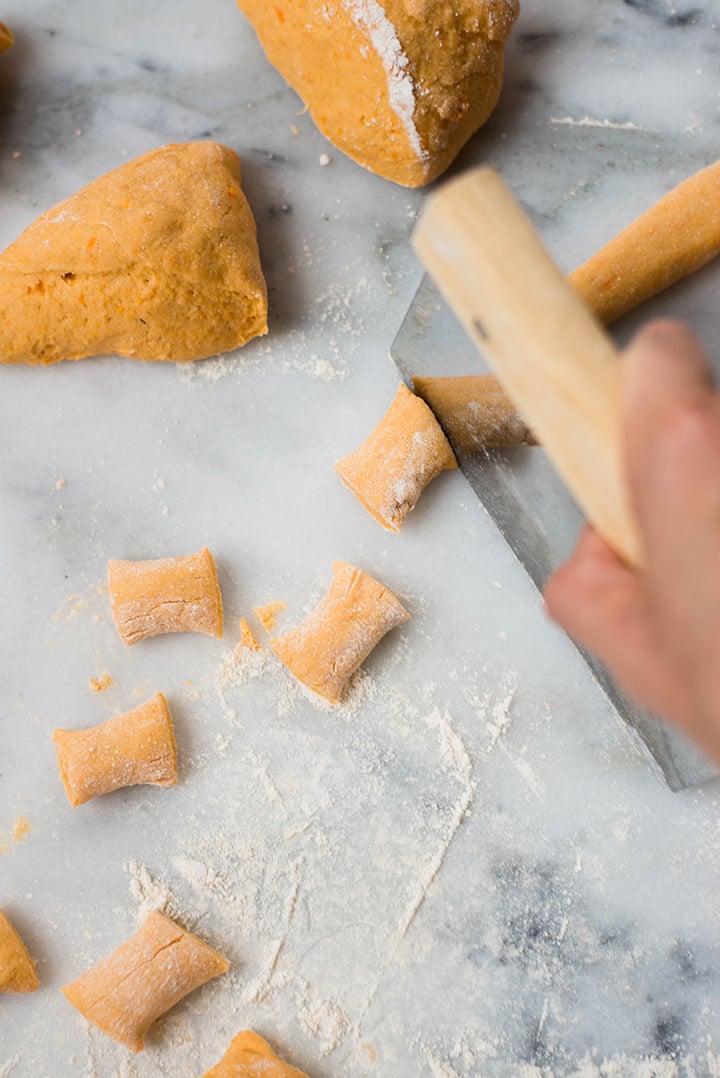
You know me – I’m all about making things as easy as possible. I don’t like to have secrets so I have to tell you how to cook pretzels in the easiest way possible. And pretzel bites, of course!
First things first – preheat the oven to 425 degrees F. Prep the baking soda bath. The baking soda bath is an essential step in our soft pretzel bites recipe. So don’t skip it. Essentially, a baking soda bath is boiled water with baking soda in it. When the water mixed with baking soda is boiling, drop the pretzel bites into it top-side down. Let them soak for about 20 seconds and remove them with a slotted spatula. Transfer the pretzel bites to the baking sheet. Sprinkle some coarse salt on top of each of them. Bake for 7-9 minutes.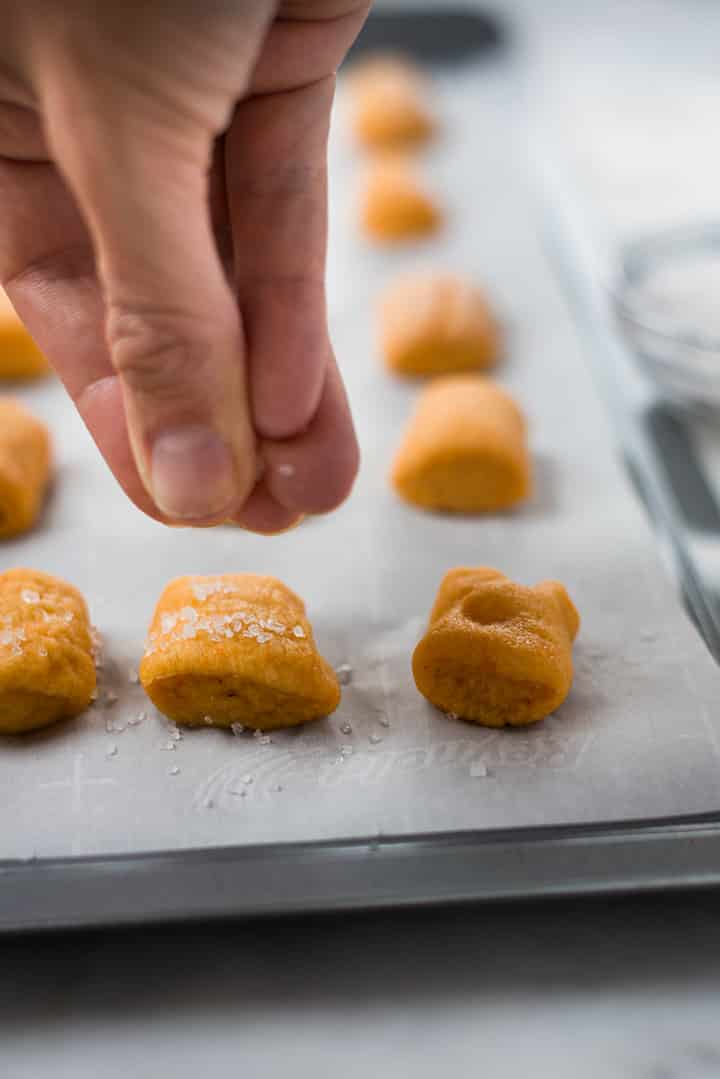
While our freshly baked pretzel bites are cooling on the wire rack, it’s time to work on our 2 dipping sauces. Most people buy cheese sauce for pretzels. Or they make pretzel cheese sauce at home. Not me. I love cheese and all, but cheese sauce is not the healthiest option. So I chose a Greek yogurt dipping sauce instead. 2, actually. One is tangy and savory. The other one sweet and cinnamony.
The first dipping sauce is a honey mustard dip made with:
Greek yogurt; Yellow mustard; Raw honey; Lemon juice.All you have to do to make the sauce is to:
Combine all the ingredients. Mix until smooth.The second dipping sauce for our soft pretzels is a sweet cinnamon dipping sauce made with:
Greek yogurt; Pure maple syrup; Vanilla extract; Cinnamon.I bet you already know how to make this dipping sauce, right?
You guessed correctly, all you have to do is to:
Combine all the ingredients. And mix until the sauce is smooth.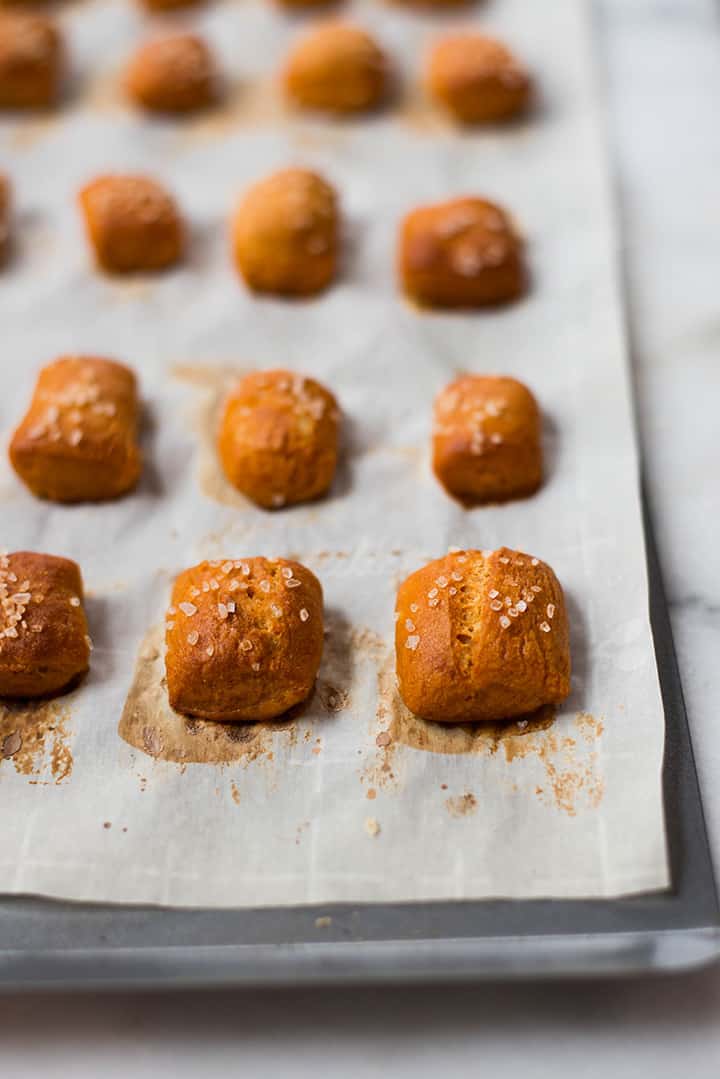
Absolutely!
You know how much I love to meal prep so the answer to your can you freeze pretzel dough question had to be YES.
You know what that means? More delicious sweet potato pretzel bites in your future.
OMG yum!
To freeze, wrap the dough in plastic wrap and transfer to the freezer where you can store it for up to 3 months.
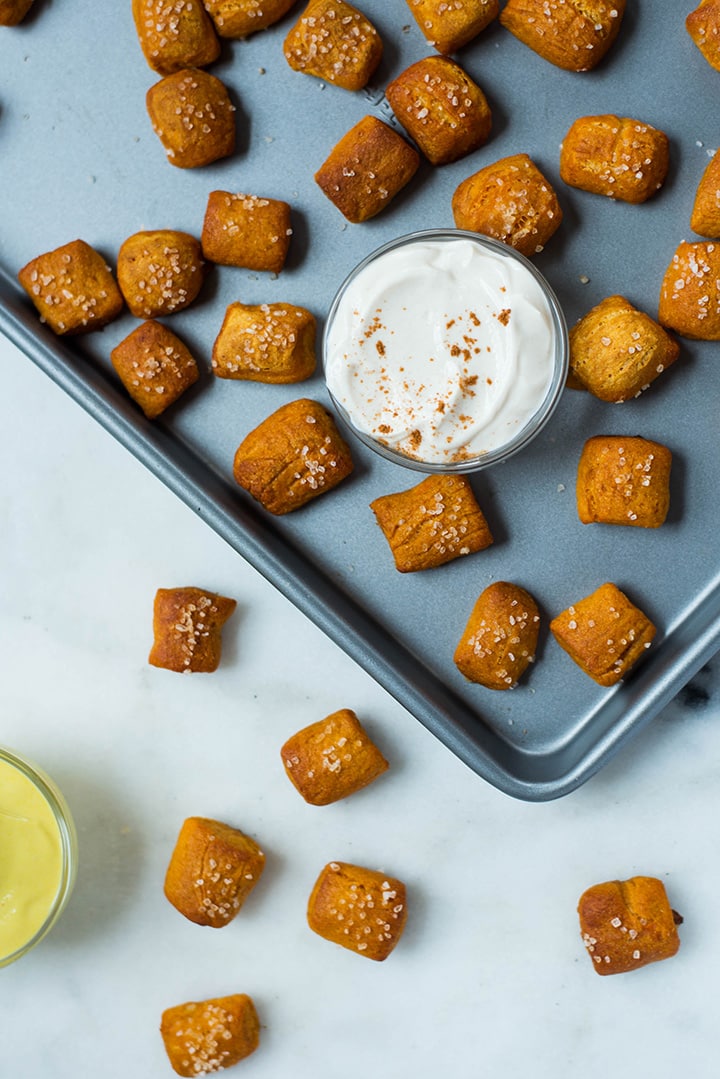
How to store soft pretzels and soft pretzel bites – I’m betting this is another question you might have.
You have 3 options to store the pretzel bites. Here’s how to store pretzel bites:
Place the pretzel bites in a paper bag and store them in a cool place. Put the pretzel bites into a plastic container and store them in the fridge for 1 day. Freeze the soft pretzel bites after you put them in an airtight container or a Ziploc bag. They last in the freezer for up to 3 months.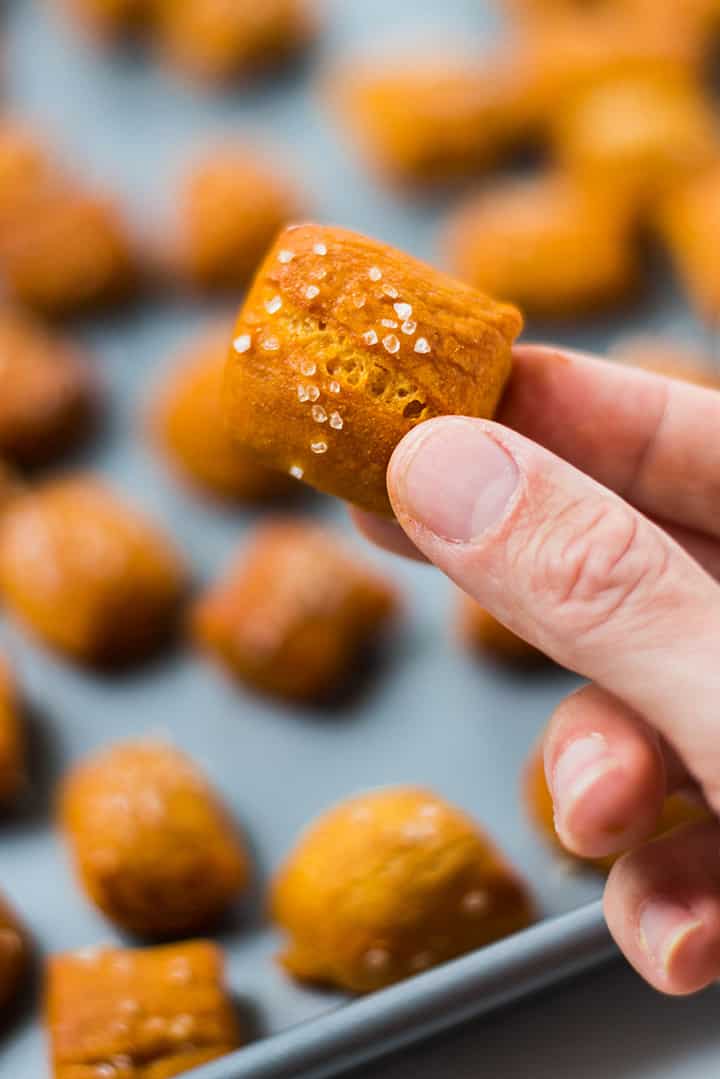
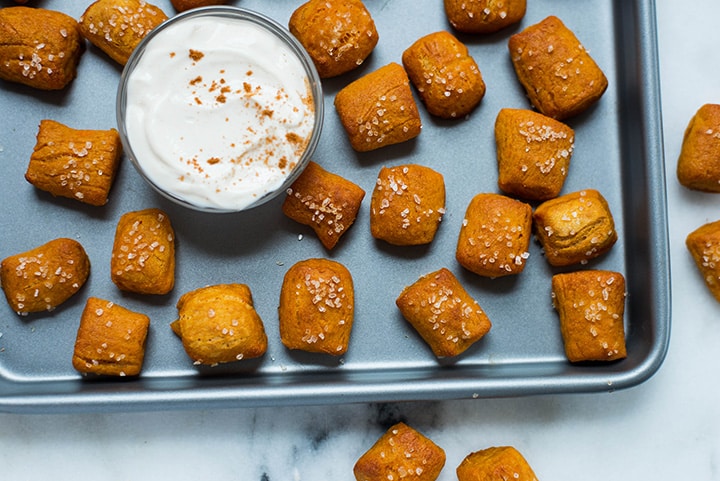
I know you know what’s coming. Yes, 3 more healthy sweet potato recipes. Because I love you and I want you to eat healthy and delicious foods. And I love sweet potatoes recipes. So putting my love for you and my love for sweet potatoes together only meant I had to share these delicious sweet potato recipes with you.
SWEET POTATO TORTILLASThese Sweet Potato Tortillas are made with only 3 ingredients. Yes, 3 ingredients. They are light, tasty, healthy and ready in 20 minutes.
These easy tortillas can be used for wraps, tacos, quesadillas, enchiladas. And by themselves. Because they really taste amazing. Get the recipe.
SWEET POTATO NACHOSYou already know these Sweet Potato Nachos are healthy and delicious. But did you also know that they are cheesy, fresh, crisp, spicy, and satisfying? If you did, you probably follow me for a while.
Perfect as a football game snack or for a party or family gathering, these Sweet Potato Nachos are simply the best. And they can be easily made vegan. Get the recipe.
EASY SWEET POTATO HASHLastly on this list of sweet potato recipes is this Easy Sweet Potato Hash recipe. This is another versatile recipe you can experiment with if you want.
Ready in 20 minutes, vegan and full of nutrients, this Easy Sweet Potato Hash makes a delicious side dish but it can be made a meal by itself. Get the recipe.

These Soft Potato Pretzel Bites are healthy, packed with nutrients, and delicious. Made with sweet potato dough to reduce the carbs and increase the nutritional value, these soft pretzel bites are just perfect for munching on during the day, and can be enjoyed guilt-free.
To proof the yeast, in a large bowl, add warm water, maple syrup, melted coconut oil, and sea salt, and stir this together until everything is dissolved.
Sprinkle active yeast over the top, and let it set for about 8-10 minutes or until the yeast turns frothy. This means the yeast is working and ready to go.
Into our proofed yeast bowl, add whole wheat pastry flour and mashed sweet potatoes. Carefully stir this together to get everything fully combined. If the dough is still very wet and sticky, you can continue to add in a little more whole wheat pastry flour, a tablespoon at a time, until the dough begins to pull away from the sides of the bowl and no longer sticks to your hand.
Lay the dough out onto a well-floured surface, and knead for 3-5 minutes or until the dough springs back most of the way when you gently press it with your finger. Let the dough rest for 5 minutes. Divide the dough in half with a sharp knife or a kitchen scraper. Then, divide that half into half until you have 8 total small wedges.Working with 1 wedge at a time, roll it into a skinny rope about 8-12 inches long.
To divide into pretzel bites, just press down to pinch off the bites using your knife or kitchen scraper every inch along the dough rope. Then, repeat with the remaining dough. Look to make the bites about 1 1/2 – 2 inches long. (To form a pretzel, take the same rope, then cross the dough the top, then cross it again, and then bring the ends down over the bottom to shape the pretzel.)
Lay a clean, dry towel over the top of the shaped pretzels or pretzel bites, and allow to rise for about 20 minutes to increase in size.Start preheating your oven to 425 degrees F, lining a baking sheet with parchment paper, and prepping your baking soda bath.
To prepare the baking soda bath, add 3 cups water plus 3 tablespoons baking soda to a small pot or deep skillet, and bring the water to a boil. Once the pretzels bites have risen, carefully take a few and place them top-side down into the boiling baking soda bath. Boil for 12-15 seconds, carefully flipping using a slotted spoon halfway through.Carefully transfer the pretzels to the prepared baking sheet using slotted spatula, and then sprinkle with some coarse sea salt. Repeat with the remaining pretzels. (If you are making sweet potato pretzels instead of the pretzel bites, I recommend brushing the formed pretzels with the baking soda water instead of boiling it. While this process works for regular flours, the combination of the sweet potato and less refined flour makes it a little tricky to hold together when completely boiled and submerged in the water.)
Now, place the baking sheet into the oven and bake at 425°F for 7-9 minutes, or until the pretzels are golden brown and cooked through. Remove the pretzels from the oven and let cool on the baking sheet for 5 minutes before transferring to a dry wire rack to cool completely. While the pretzels are cooling, we can make our honey mustard dipping sauce. In a small bowl, combine the plain Greek yogurt, clean yellow mustard, raw honey, and freshly squeezed lemon juice. Whisk until this is very smooth. If you want something a little sweeter and less tangy, instead you can make my sweet cinnamon greek yogurt dip by combining plain greek yogurt, pure maple syrup, vanilla extract, and ground cinnamon in a small mixing bowl. Both dips are great with these baked sweet potato pretzel bites, just either sweet or savory.The sweet potato can be cooked from roasting, boiling, or steaming. I remove the skin for this recipe.
This post contains affiliate lnks for products I use often and highly recommend.
The post Sweet Potato Soft Pretzel Bites (with Sweet Potato Dough!) appeared first on A Sweet Pea Chef.
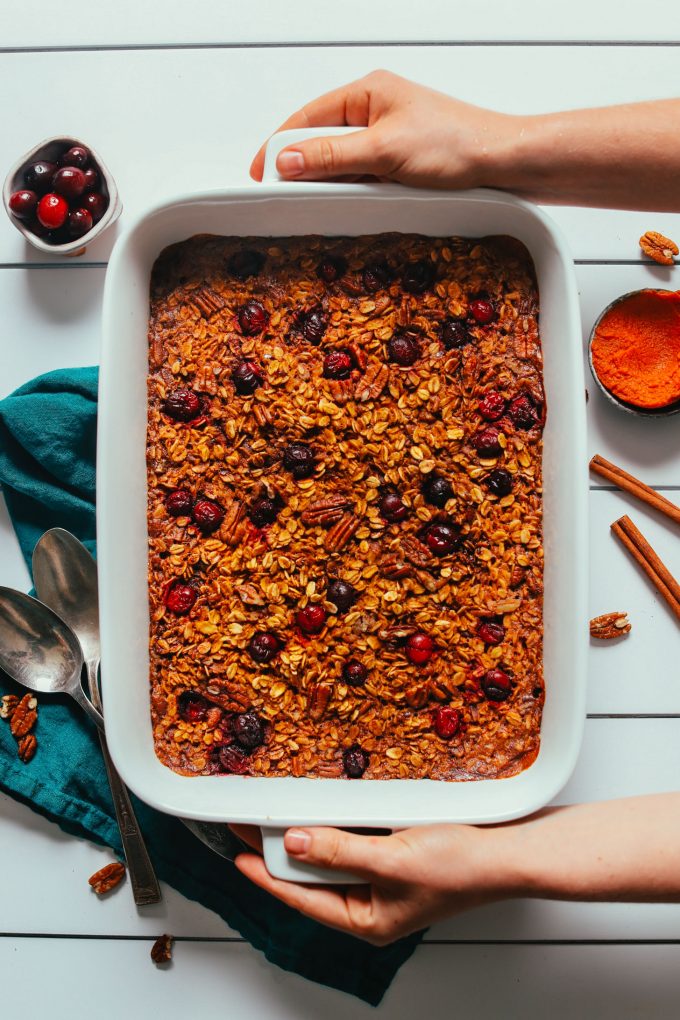
Behold: Autumn in a dish. Those colors, those flavors – swoon.
It has so many of my favorite ingredients, like oats, pumpkin, cinnamon, and maple syrup, and bakes up so beautifully. Consider this dish your 1-bowl go-to when oatmeal cravings hit. Let’s bake!
This dish begins with flax eggs. Then we add pumpkin puree, maple syrup, pumpkin spices, and a little oil (for moisture and to help crisp the edges).
Pumpkin Baked Oatmeal from Minimalist Baker →
Looking for easy finger food recipes for a crowd? This white chili cheese dip is perfect for entertaining, baked in a skillet covered in gooey Tillamook cheese.

This post was created in partnership with Tillamook. All opinions are our own.
With the turn to cooler weather and comfort food cravings, we’ve got you covered with this skillet white chili cheese dip! Check out that gooey, melty cheese, right? We created this chili cheese dip recipe espcecially for entertaining. It’s perfect for fall parties: tailgating, a game day gathering, or a party table full of easy finger food recipes for a crowd. It’s a Mexican-style cheese dip that’s a play on white chili, using white beans, mild green chiles, corn, and a gooey mess of Mexican cheeses (sans the typical chicken so it’s vegetarian!). For this recipe, we’re showcasing a cheese that’s truly best in class: Tillamook Farmstyle Cut Shredded Cheese. These shreds are giant and designed to make the ideal melt, stretch, texture and flavor for baked dishes. Keep reading for the chili cheese dip recipe, and more about that melty cheese.

As food bloggers and cookbook authors, Alex and I have tried a lot of different products over the years. We both agreed that this Tillamook Farmstyle Cut Shredded Cheese is truly something special. The shreds are huge, triple the size of standard shreds, which makes for an even, gooey melt. And the flavor is incredible. We used the Mexican 4 Cheese flavor in this chili cheese dip recipe, a blend of Cheddar, Monterey Jack, Queso Quesadilla, and Asadero. We also like to snack on the shreds while cooking, since they’re so tasty and easy to grab! Here’s a little more info on Tillamook Farmstyle Cut Shredded Cheese:
It has a hand-grated texture and is crafted to deliver ideal melt, stretch, texture and flavor. It’s grated straight off of 40 lb. blocks of award-winning, naturally aged Tillamook Cheddar. The cheese is made with the highest-quality milk from cows that are not treated with artificial growth hormones. It’s also: Bigger – The New Farmstyle Cut is bigger than other shreds Meltier – Has a smoother, more even melt and fuller body Tastier – More flavorful because they are made with real, high-quality Tillamook CheeseWondering where to buy Tillamook? Find Tillamook Farmstyle Cut Shredded Cheese in a grocery near you by entering your zip code here.

This white chili cheese dip is very simple to make. The base is made creamy using blended pinto beans, creamy Greek yogurt, garlic, and some Mexican spices. Blend it up and stir it together in the skillet with Mexican cheese, white beans, and green chiles, which are part of the play on white chili. Top with extra Mexican cheese, red peppers, green onions and corn, and pop it in the oven until the cheese is gooey. It makes the kitchen smell divine and is a total hit at parties. (Ours already has been downed multiple times!) If you’re into a little spice, add the hot sauce: the amount we’ve called for only adds a subtle kick. And of course, it’s over the top good with those Tillamook Farmstyle Cut Shredded Cheese. Note that if you’re serving it at a party, we recommend making in advance then reheating in the host’s oven (or assembling it all prior to the baking step).

This white chili cheese dip recipe is perfect for game day, or a party table full of easy finger food recipes for a crowd. A few of our top game day finger food recipes:
Healthy Loaded Sweet Potato RoundsVegetable Hummus Tortilla RollupsPesto Grilled Cheese Dippers with Marinara Looking for cast iron skillet recipes?
Looking for cast iron skillet recipes?
This white chili cheese dip recipe is made in a cast iron skillet–which of course, you don’t have to use, but it’s fun if you do! Here are a few other cast iron skillet recipes from A Couple Cooks:
Loaded Grilled NachosSweet Potato Feta Dinner SkilletSkillet Apple CobblerThis recipe is…This white chili cheese dip recipe is vegetarian and gluten-free.


Looking for easy finger food recipes for a crowd? This white chili cheese dip is perfect for entertaining, baked in a skillet covered in gooey cheese.
Preheat oven to 375F.
Peel the garlic cloves, then add them to the bowl of a food processor and pulse until chopped. Drain the pinto beans. Add the pinto beans, Greek yogurt, cumin, oregano, chili powder, onion powder, and 1/2 teaspoon kosher salt. Process until smooth, about 1 minute.
Brush a cast iron skillet or 9 x 9″ pan with olive oil and pour bean mixture into the skillet. Drain the white beans. To the bean mixture, stir in the white beans, 1/2 cup Mexican cheese, green chiles, hot sauce (optional), and 3/4 teaspoon kosher salt.
Mince the red pepper and thinly slice the green onions. Top the white chili cheese dip with 1 to 1 1/2 cups Mexican cheese (depending on your cheese preference!), red pepper, green onions, and frozen corn.
Bake for 20 minutes until cheese is melted*. Serve warm with tortilla chips.
*If you’re serving this chili cheese dip at a party, we recommend making in advance then completing Step 5 baking in the host’s oven. (You can also bake it in advance and reheat, but the just melted cheese from the oven is the best part!)
Keywords: Chili Cheese Dip, White Chili Cheese Dip, Finger Food, Finger Food for Parties, Party Recipe, Entertaining, Vegetarian, Gluten Free
A Couple Cooks - Recipes for Healthy & Whole Living
This sourdough bread recipe is the ultimate guide to making your own sourdough bread! Easy to follow instructions, a printable checklist, and a step-by-step video help you master that tangy flavor, chewy crust, and perfect texture.

Ready to get your hands dirty with the best sourdough bread recipe on the internet? Making sourdough bread at home is one of the most satisfying, life changing things you can do. It’s tastier, healthier, and cheaper than any bread you’ll ever buy. As two professional home cooks with previous careers in business writing, Alex and I leveraged our skills for making complex processes simple and created our best sourdough bread recipe, the Simplified Guide for Sourdough Bread. It has easy to understand steps, a video, and a printable checklist to make sure you’re able to master how to make sourdough bread. Keep reading for our sourdough bread recipe and all you need to know about how to make sourdough bread at home.
Related: How to Make Sourdough Starter–Out of Thin Air! | How to Feed (and Love) Your Sourdough Starter
Our master video: Sourdough Bread RecipeWatch Alex show you everything you need to know about this sourdough bread recipe! So much of bread making is learning by watching, so we knew we couldn’t publish a recipe without a video.

This sourdough bread recipe is years in the making. For the past 2 years, Alex and I have been making sourdough bread every week. In that time, we’ve learned that making sourdough bread is a complex process. But! We’re also passionate about Pretty Simple Cooking. So we wanted to simplify the process so that everyone on the planet could learn how to make sourdough bread. We set out to make the best sourdough bread recipe on the internet — that is, the most repeatable, easiest to follow recipe in the world. A recipe complete with a printable checklist and a step by step video.
So here it is: our simplified sourdough bread recipe! It’s our original A Couple Cooks recipe, though it was partially inspired by recipes from the Tartine cookbook and The Perfect Loaf. Our perfect sourdough bread? We love a chewy crust, tangy flavor, and just enough holes in the bread to be interesting but still hold up to a slather of peanut butter. Our sourdough bread recipe is the perfect everyday bread for snacking, sandwiches, and serving with soup. Ready to dive in? Before you start, read this post in detail so you understand the necessary tools and concepts! And if you have any questions, let us know in the comments below.
We’d love to see your loaf! Use #PrettySimpleSourdough to share on social media.

Making sourdough bread is a process that spans across 3 days. Here’s an outline of the tasks and approximate active time for how to make sourdough bread:
Day 1 Evening: Feed the starter (5 minutes active time) Day 2 Make bread and proof overnight (5 hours active time) Day 3 Bake (1 hour active time)As you can see, it’s a bit of an involved process! So then why is our sourdough bread recipe simpler than other recipe? We’ve thoughtfully crafted easy to follow instructions that you can even memorize (we have!). Our recipe uses a Dutch oven for cooking the bread instead of steam, which can be hard to create at home. And, we have created a custom video series and printable checklist so that you don’t miss a step. The hardest part is waiting for the bread to cool!
How to make this sourdough bread recipe? Scroll to the very end of this post.

Making sourdough requires some special equipment to get the job done. Here’s a list of the required tools. We’ve linked to the exact tools that we use, but you can use whatever suits you!
Required Tools for this Sourdough Bread Recipe Large dutch oven for baking the breadAn active sourdough starter (here’s how to make it)Plastic bag for proofing (reuse it every time you make bread)500 gram oval banneton proofing basket where the dough has its final rest (prounounced ban-eh-TONE)Kitchen scale for measuringOur printable Sourdough Bread Checklist Parchment paperBench scraper for shaping the doughDough whisk for quickly and easily stirring the dough mixture (optional)Lame (pronounced lahm) or sharp knife for scoring the breadOven gloves for easily removing the bread from the oven (optional; not shown)
You can make sourdough bread with many different types of flour. For our sourdough bread recipe, we use a mixture of all-purpose flour (for texture), bread flour (for strength), and whole wheat flour (for flavor). We find that this mix gives us the type of bread we love: a moderately open crumb (those beautiful holes in sourdough), a chewy crust, and tangy flavor. Personally, we use King Arthur brand organic flour for all of these flours. In testing many different flours, we find it has the best and most consistent results for our sourdough bread recipe. (Some other flour brands we’ve tried made for dense bread.)

So, what’s proofing? Proofing is when you let bread dough rest after you’ve added yeast so that it rises. In this recipe, there are multiple steps that involve proofing, some at room temperature and some in a warm area. What’s the optimal sourdough bread proofing temperature? For best results, your sourdough bread proofing temperature should be between 80°F and 90°F.
The recipe below calls for setting up a proofing area where the bread can sit at this temperature. If you have it, use the proofing setting on your oven for this step. Other options: you can turn on the oven to preheat for about 1 minute and then turn it off before you place the dough in the oven. Or, you can pour a few cups of boiling water into the oven beneath your bowl to raise the temperature. Just be careful not to accidentally turn on the oven for any other reason while the bread is proofing! (We’ve had this happen before, and it’s not pretty!) You could do the entire recipe at room temperature, but the resulting dough will be less consistent and the timing will be almost double on the final proof.

For the final proofing stage in our sourdough bread recipe, the bread proofs in a basket called a banneton. The banneton helps to shape the bread and also makes for the lovely decorative lines that are indented on the top of the bread. To ensure that the bread doesn’t stick to the banneton, we use a mix of 1/2 cup all purpose flour and 1/2 cup rice flour for the banneton, a tip we learned from the Tartine cookbook. We keep a container full of this mix on hand for the bread. When it’s not in use, you can store the banneton at room temperature. There’s no need to clean the banneton; you can just let it dry out. After every few bakes, we scrape out the excess flour with a spoon so that you can still get those nice decorative lines in the top of the dough.

Sourdough bread is a naturally leavened bread: meaning that instead of using active dry yeast to rise, it uses a sourdough starter! The first step in our sourdough bread recipe is to feed the sourdough starter. The night before you decide to make bread, feed the sourdough starter following the instructions in the recipe below. Learning how to care for your starter is an important part of this sourdough bread recipe. To learn about how to feed your sourdough starter, see our post and video about How to Feed Sourdough Starter.
If you don’t have a sourdough starter yet, never fear! You can learn how to make sourdough starter at home: and it’s really simple. See our post and video about How to Make Sourdough Starter–Out of Thin Air!
What is baker’s percentage?If you’ve read up on sourdough bread, you may have heard of the terms “baker’s percentage” or “hydration level”. These terms refer to the amount of water in the recipe, as compared to the amount of flour. This sourdough bread recipe is a high hydration bread; the baker’s percentage is 78% hydration (350 grams of water / 450 grams of flour).

Once you’ve baked your homemade bread, it is best eaten within 48 hours. We store ours wrapped in cloth at room temperature (we made a special bread bag for storage out of a large napkin). If you don’t think you’ll eat the entire loaf in 48 hours, you can freeze whatever you don’t think you’ll eat! Let the sourdough bread cool fully to room temperature, then cut it into slices and place it into a sealed bag or container.

Last thing: as we’ve honed this recipe through the years, we found that the hardest part of making sourdough bread was keeping track of which step we were on! To solve that problem, we created this easy to follow printable checklist so that you don’t miss a beat. Filling in the circles also adds satisfaction to each step! You can reuse the checklist five times; after that, print a new checklist and you’re good to go.
Are you ready? If you’ve made it this far, you’re ready to learn how to make sourdough bread at home. See the master recipe below — and don’t forget that printable! Let us know any questions in the comments. Happy baking!

This post is one of three in our series on how to make sourdough bread at home:
How to Make Sourdough StarterHow to Feed Sourdough Starter

This sourdough bread recipe is the ultimate guide to making your own sourdough bread! You’ll be amazed by the tangy flavor, beautiful chewy crust, and perfect texture. And don’t forget the printable checklist!
On Day 1, you’ll be simply feeding your sourdough starter the night before you prepare the dough.
Feed the starter: Remove the active starter from the refrigerator at 9 pm. Discard all but one tablespoon of the starter. Add 50 grams of purified water and 50 grams of all purpose flour. Stir, cover, and leave at room temperature overnight. The starter should be bubbly and about doubled in size between 9:00 am and 11:00 am the following day. (More about feeding your starter is at How to Feed Sourdough Starter.)
Print the printable checklist: Print off our Sourdough Bread Checklist to use when baking the dough tomorrow!
Day 2: Preparing the DoughOn Day 2, you’ll be making and proofing the dough. This is the most labor intensive day. Overall, the process will take around 5 hours; it’s a great weekend activity. The numbers below correspond to the printable checklist; make sure you have it printed and ready to go!
1 Mix flour and water; rest for 1 hour at room temp (“autolyse”): In a small mixing bowl, combine the three flours (from the recipe above) with the purified water. Use a spoon or dough whisk to stir until all dry flour has been incorporated into a raggy dough. Cover the bowl with plastic wrap or place the bowl in a large ziplock bag and place leave room temperature. Set timer for 1 hour.
2a Prepare the proofing area: Prepare a warm area for proofing before starting next step. For best results, the proofing should be in a warm location, between 80° and 90° degrees.
2b Stir in the starter and proof for 30 minutes: Add the starter to the dough and stir until loosely incorporated. It does not need to be perfectly stirred in. Cover the bowl and place in the warm area for proofing. Set timer for 30 minutes.
Watch the video instructions for about folding for the next few steps.
3 Add salt, mix with hands, and proof for 30 minutes: Add the kosher salt evenly across the dough and mix the dough with your hands until the salt is incorporated. See video above to watch how to mix the dough. Return the covered dough to the proofing area and set timer for 30 minutes.
4 Fold and proof for 30 minutes: Fold the dough: with wet hands, lift one side of the dough straight up so that it stretches and fold it across the center; turn the bowl a quarter turn and repeat 4 times. Lift up the dough and wrap it onto itself until you have a smooth surface, then flip it over and place it in the bowl seam side down. See video above to watch how to fold the dough. Return the covered dough to the proofing area and set timer for 30 minutes.
5 Fold and proof for 45 minutes: Fold the dough again in the same way as Step 4, wrapping it as much as possible without tearing the dough. Return the covered dough to a warm area and set timer for 45 minutes.
6 Gently fold and proof for 1 hour 30 minutes: Gently fold the dough in the same way as Step 4, being carefully not deflate built up air in the dough. Return the covered dough to a warm area and set timer for 1 hour.
Before you start, watch the video for instructions on pre-shaping and shaping the dough.
7 Pre-shape the dough and rest for 30 minutes at room temp: At this point the dough should appear bubbly on top and wiggle when shaken. (If it is not ready, proof for a few more minutes; the timing can vary depending on the temperature of your proofing and variations in the starter.) Turn the dough onto an unfloured countertop. Lightly flour the top of the dough and then use a bench scraper to gently scrape the dough into a ball, creating tension on top. Do not go so far that you tear the dough. Place an inverted bowl over the top of the dough. Set timer and rest the dough for 30 minutes.
8 Shape the dough, place in banneton, and rest for 30 minutes at room temp: Prepare the banneton by rubbing the 50/50 rice flour mixture into all of the grooves of the banneton. Remove the bowl from over the dough, which should be formed into a gently rounded shape. Rub just enough flour onto the top of the dough so that it isn’t tacky. Use the bench scraper to flip the dough so that the floured side is down. Gently stretch the dough into a rectangle. Moving quickly, fold the top third of the dough down, and the bottom third up to create a packet. Rotate the dough 90 degrees and gently roll it into a log shape. Be careful to not press the dough or deflate it. Use your hands to gently pull the dough tight and pinch off the seams at the end of the dough. Rub a little more flour onto the top of the dough so that it isn’t tacky. Gently flip the dough into the banneton and pinch off the bottom seam. Place the banneton into the proofing bag and set timer for 30 minutes.
9 Refrigerate overnight: Place the banneton in bag in your refrigerator until the following morning.
Day 3: Baking the Dough10 Preheat the dutch oven at 515°F for 30 minutes: The following morning, place a covered Dutch oven on the center rack in your oven. Preheat to 515°F for at least 30 minutes. If your oven only reaches to 500°F, the recipe will still work but you won’t get quite as much rise out of the bread.
11 Place on parchment, score, and bake for 17 minutes in Dutch oven:
After preheating, cut a piece of parchment paper the width of your banneton. Remove the banneton from the refrigerator and pull back slightly around the edge of the dough to release it from the banneton. Gently invert the banneton onto the parchment paper and reach your hand into the basket to release it from the banneton. Try not to deflate the dough. Using a lame or sharp knife, cut a shallow slit at angle across the top of the dough. You can also add additional small shallow cuts for decoration. As quickly as possible, remove the lid from the Dutch oven and carefully place the parchment paper with dough into the Dutch oven. Cover it and set the timer for 17 minutes.12 Place bread on rack, reduce to 400°F and bake for 23 minutes: After 17 minutes, reduce the oven temperature to 400°F. Remove the Dutch oven and carefully take out the bread and set it directly on oven rack. Bake an additional 23 minutes. Remove the bread from the oven and allow to cool on a cooling rack for at least 45 minutes.
Eat immediately. Store in a bread bag on the counter for up to 2 days, or freeze wrapped in foil in a plastic bag for several months.
Keywords: Homemade Sourdough Bread, Homemade Bread, How to Make Sourdough Bread, Best Sourdough Bread, Easy Sourdough Bread
A Couple Cooks - Recipes for Healthy & Whole Living
This sourdough starter recipe shows how to make a sourdough starter from scratch. You can make a starter for bread at home out of thin air!

Are you looking to start baking sourdough bread at home? As part of our series How to Make Sourdough Bread: The Simplified Guide, we’re showing you how to make a sourdough starter at home! A sourdough starter is essential for making sourdough bread. Though you can order one online or find one from a friend, why not make it at home? It’s simple and requires very little hands on time. Wait for 5 days, and you’ll have grown your own sourdough starter—out of thin air! Keep reading for how to make sourdough starter.
Watch how to make sourdough starterBut first, here’s our video on the process: watch Alex show you how to make sourdough starter!
 What is sourdough starter?
What is sourdough starter?
A sourdough starter, also called levain, is a fermented dough filled with natural, wild yeast and a bacteria called lactobacilli. The sourdough starter is what makes sourdough bread rise. Instead of using active dry yeast like in other bread recipes, the sourdough starter is used for sourdough bread. Along with leavening the bread, the starter also brings that classic sour flavor.
A sourdough starter is literally full of life! There are 50 million yeasts and 5 billion lactobacilli bacteria in every teaspoon of starter dough. Sound weird? Actually, humans have been doing this for thousands of years; the process of making sourdough starter is as old as bread itself. For over 5,000 years, humans have mixed flour and water, waited for it to ferment, and then used it as leavening for bread. Ready to take part in the ancient practice of making sourdough starter for yourself?
Interested in the science behind sourdough starter? Read more here.
 Making sourdough starter
Making sourdough starter
Making sourdough starter is a simple process. You simply mix together flour and water, and then wait, wait, and wait so more for the yeast and bacteria to do their thing! It’s a 5 to 6 day process that mostly consists of waiting. For our sourdough starter recipe we use a mix of whole wheat and all-purpose flour to give the start a jump start. Once the starter is active and vibrant, we switch to all purpose flour for regular feeding of the starter.
And that’s right, we said feeding a starter! Since this little dude is alive (see above), you’re going to have to feed him or her regularly. See our post on How to Feed a Sourdough Starter. You may want to give him a name too! (Ours is Starty. Original, right?)
Scroll down to get our full recipe for making sourdough starter, below!
 What you need for making your own sourdough starter
What you need for making your own sourdough starter
Luckily, you don’t need too many special tools for making sourdough starter. (Don’t worry, you’ll need special tools when we get to How to Make Sourdough Bread!) Here’s what you need for making sourdough starter at home:
A covered jar to store your sourdough starter (any will work: we use this one) Whole wheat flourAll purpose flourFiltered water, at room temperature (we use this pitcher to filter our tap water) Kitchen scale (here’s the one we use)
One more thing before we get down to it: what can you make with sourdough starter? Sourdough bread, obviously! Here’s our How to Make Sourdough Bread: The Simplified Guide, complete with printable to make the process pretty simple.
Beyond bread, there are all sorts of things you can make with sourdough starter: pancakes, waffles, cookies, pizza crust, and muffins. Check out some uses here: Beyond the Loaf: The Many Uses of Sourdough.
Related postsThis post is one of three in our series on making sourdough bread:
How to Make Sourdough Bread: The Simplified GuideHow to Feed Sourdough Starter

This sourdough starter recipe shows how to make sourdough starter from scratch. No need to order online, you can make a starter for bread right at home!
Day 1: Use a kitchen scale to add 25 grams whole wheat flour, 25 grams all-purpose flour, and 50 grams of water. Stir to combine. The mixture should look like a thick paste. Cover the jar and place in a warm location for 24 hours. The temperature of your room can have a big effect on the speed at which your starter grows. Ideally, you want to be between 68 and 72 degrees. The starter will not flourish in cooler temperatures.
Day 2: You may or may not see a few bubbles starting to appear in the starter. Either way, discard about half of the starter and add the same ingredients to the jar: 25 grams whole wheat flour, 25 grams all-purpose flour, and 50 grams of water. Stir to combine. Cover the jar and place in a warm location for 24 hours.
Day 3: You will likely see a few more bubbles today. The starter should start to smell a little bit sour (in a good way!) Again, discard half of the starter. Today, you’ll switch to using only all-purpose flour. Add 50 grams all-purpose flour and 50 grams of water. Stir to combine. Cover the jar and place in a warm location for 24 hours.
Day 4: You should see a lot more bubbles and the starter should increase in volume. Follow the same process: discard half of the starter. Add 50 grams all-purpose flour and 50 grams of water. Stir to combine. Cover the jar and place in a warm location for 24 hours.
Day 5: The starter will be very bubbly and double in volume. It will have a funky sour smell that indicates the magic of sourdough is ready to happen! This starter is ready to use! Follow our instructions for feeding and maintaining a starter to keep it alive on the long term.
Depending on your room temperature conditions, it might take several more days of the same process to get the starter to be really bubbly and active!
Keywords: Sourdough Starter, How to Make a Sourdough Starter, How to Grow a Sourdough Starter
A Couple Cooks - Recipes for Healthy & Whole Living
Wondering how to feed sourdough starter? Here’s all you need to know about on feeding and maintaining sourdough starter, including how to tell if your sourdough starter is bad.

Got a sourdough starter? If you’re baking sourdough bread at home and suddenly mom or dad to a sourdough starter, the new responsibility might feel overwhelming! Luckily, feeding and maintaining sourdough starter is quite simple. As part of our series How to Make Sourdough Bread: The Simplified Guide, we’re showing you how to feed sourdough starter. A sourdough starter is essential for making sourdough bread. And in order to have bread on the regular, you have to learn to feed sourdough starter to keep it happy and healthy. Keep reading for how to feed sourdough starter, storing and maintaining sourdough starter, and how to tell if sourdough starter is bad.
Watch how to feed sourdough starterBut first, here’s our video on the process: watch Alex show you how to feed sourdough starter!
A sourdough starter, also called levain, is a fermented dough filled with natural yeast. The starter is used to make sourdough bread rise and give it that characteristic sour flavor. If you’ve ended up here, we assume at this point you already have a sourdough starter on hand.
But if you don’t have a sourdough starter, did you know you can make it at home? Here’s our guide on how to make sourdough starter, complete with all our tips. You also can get a sourdough starter from a friend or purchase it online…but what’s the fun in that? Making sourdough starter takes very little hands on time. It takes 5 days of waiting time before the starter is active and ready to go.

To store your starter, you’ll need a sourdough starter container. Any covered jar will work, but here’s our the sourdough starter container. Just place the starter right into the container, which is now his or her home. (Note: Over time the starter’s home can become gummy: every week or two, take the starter out of the container and wash it, then replace the starter and follow the normal feeding instructions below.)
You’ll want to store your starter in the refrigerator until you’re ready to make bread. When you make bread, you’ll feed the sourdough starter the night before (see the recipe below), then return the sourdough starter to the refrigerator until you’re ready to bake again.

So, you’ve got a sourdough starter and it lives in its container in the refrigerator. What’s the frequency for feeding sourdough starter?
You can leave the starter in the refrigerator for 3 to 4 days at a time between feedings. We recommend feeding sourdough starter at least twice a week for best results.Remember, if you’re planning to make bread on a given day, you’ll feed sourdough starter the night before you bake. So depending on how often you want to make bread, you may end up feeding your starter more often. For us, we make a loaf of sourdough bread about 4 times a week, so we feed it 4 times per week (every night before we make bread). If we have a week where we plan to make less bread, we’ll still feed the starter 2 times per week, regardless of whether we’re making bread. What are the actual steps for how to feed sourdough starter? Go to the recipe below.If you’re actively using your starter to make our Sourdough Bread recipe, the instructions in the recipe below will allow just enough leftover sourdough starter to have enough starter for the next day’s bread. If you’re not making bread every few days, you’ll need to discard excess starter as part of the feeding process to keep it healthy and happy.
What is a healthy sourdough starter like? A healthy starter smells funky and fruity, in a good way. It’s a floury paste that’s lightly bubbly. If things start to take a turn, see the Troubleshooting section below.

Every once in a while something can go wrong with your starter. If you don’t feed it often enough, the sourdough starter starts to smell like alcohol. You may also find that the starter loses its vibrancy and doesn’t get too bubbly and active after a feeding. Don’t worry, you can always get the starter to recover. Throw away all but about a teaspoon of the starter and nurse it back to life following the instructions for making a sourdough starter. It should take 5 days or less to be healthy again.

What if you want to go on vacation: what should you do with your sourdough starter? In our experience, we’ve found that if you’re leaving for over a week, it’s best to discard your sourdough starter and start again with the process of making a sourdough starter. Of course if you have a friend or family member who can babysit your sourdough starter, that’s even better! Actually, in Sweden you can hire a babysitter for your sourdough starter. So maybe it’s not so far fetched!
Alright, if you’ve made it this far you’re ready to learn how to feed sourdough starter. See the recipe below!
Related postsThis post is one of three in our series on making sourdough bread:
How to Make Sourdough Bread: The Simplified GuideHow to Make a Sourdough StarterPrint
Wondering how to feed a sourdough starter? Here’s all you need to know about on feeding and maintaining sourdough starter, including how to tell if your sourdough starter is bad.
Note: Our sourdough bread recipe calls for 80 grams of sourdough starter, leaving 20 grams of starter for the next batch. If you’re using a different bread recipe that calls for more starter, you can add any amount of flour and water as long as the weights are the same.
Keywords: Bread, Sourdough Bread, Sourdough Starter, Feeding, Starter, Baking,
A Couple Cooks - Recipes for Healthy & Whole Living

The BEST healthy 7-layer dip ever made with beans, yogurt, taco seasoning, guacamole, cheese, tomatoes, black olives, onion, cilantro and jalapeños. Fresh, flavorful and absolutely delicious! Always a crowd-pleaser for game day and even holiday parties. This recipe is sponsored by siggi’s. You know what I’m always down for? A good snack. While I don’t [...]
The post Fresh & Healthy 7-Layer Dip appeared first on Ambitious Kitchen.
from Merah Hati Cintaku https://ift.tt/2q7ejq8
via MerahHatiCintaku.blogspot.com
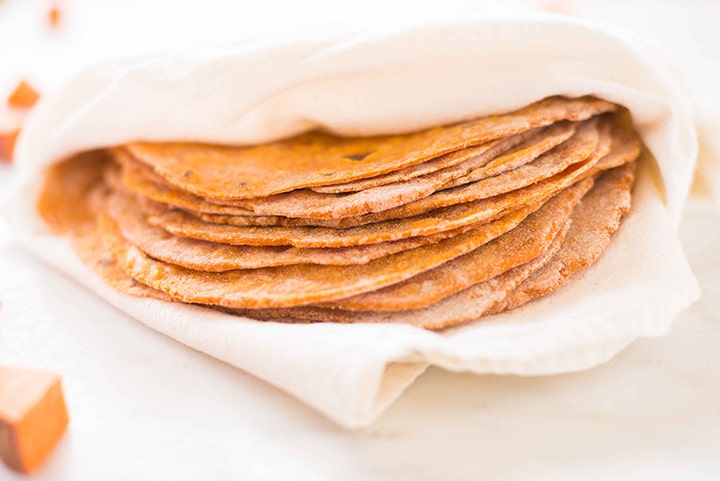
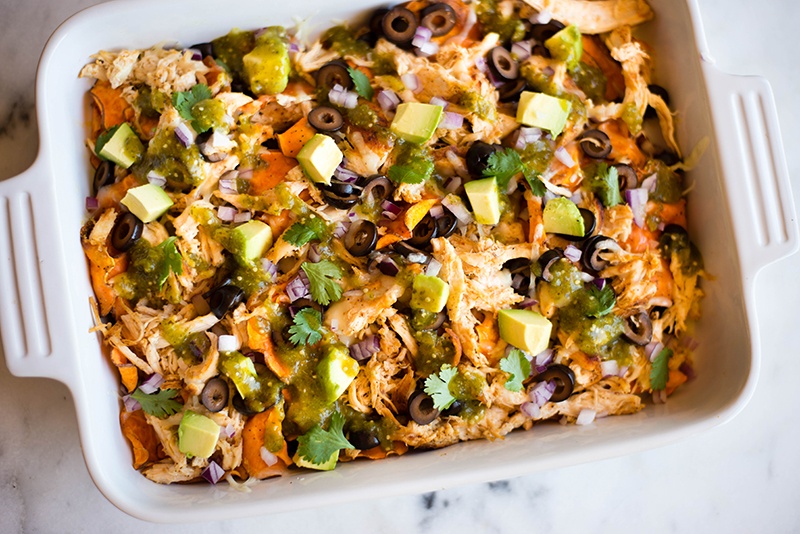
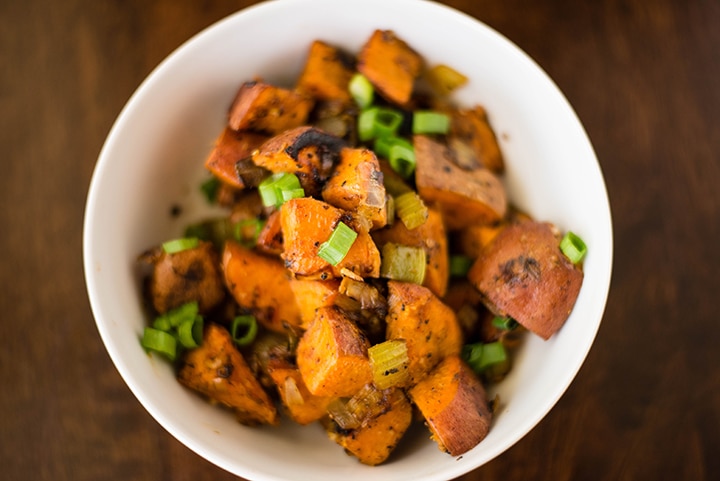
 (1 votes, average: 5.00 out of 1)
(1 votes, average: 5.00 out of 1)